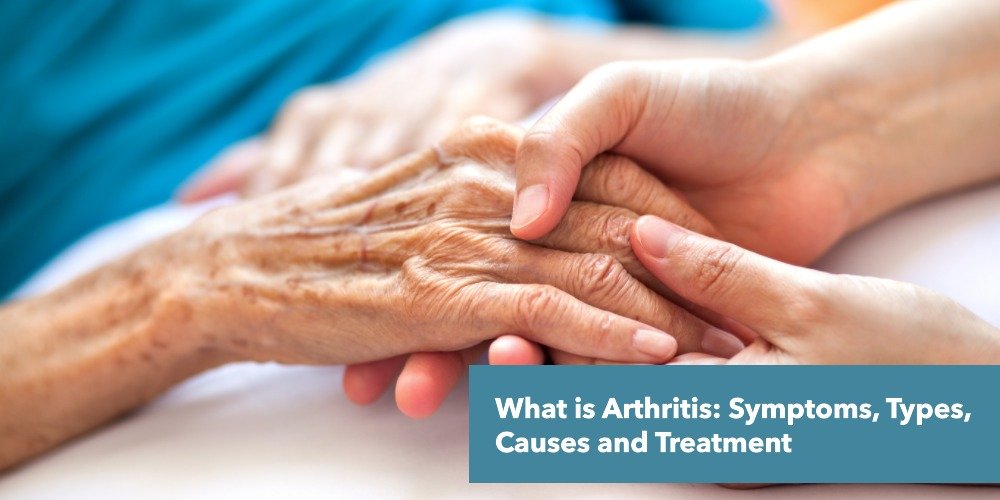What is Arthritis?
Arthritis is a medical condition that causes inflammation in one or more of your joints, leading to pain, stiffness, and reduced movement.
What are the Types of Arthritis?
There are more than 100 types of arthritis, but the most common ones include Osteoarthritis, Rheumatoid Arthritis, Psoriatic Arthritis, Gout, and Ankylosing Spondylitis.
Osteoarthritis (OA)
This is the most common form of arthritis. It occurs when the cartilage that cushions the ends of your bones wears down over time. You may feel pain, stiffness, and swelling in joints like your knees, hips, hands, or spine. OA typically worsens with age and is often linked to joint overuse, injury, or genetics.
Rheumatoid Arthritis (RA)
RA is an autoimmune condition, which means your immune system attacks healthy joint tissue by mistake. This leads to painful inflammation, joint damage, and loss of function. It often starts in the hands or feet and can affect both sides of your body at the same time. RA can also cause fatigue, weight loss, and affect organs like the lungs or heart if not treated early.
Psoriatic Arthritis (PsA)
This type of arthritis happens in people who have psoriasis, a skin condition. PsA causes joint pain, swelling, and stiffness, often along with skin patches. It may affect the fingers, toes, lower back, and even nails. The symptoms can come and go, and early treatment helps prevent long-term joint damage.
Gout
Gout is caused by a buildup of uric acid crystals in the joints, usually from consuming high-purine foods like red meat or alcohol. It often affects the big toe first and causes sudden, intense pain, swelling, and redness. Gout attacks can be very painful but are treatable with lifestyle changes and medications.
Ankylosing Spondylitis (AS)
AS is a chronic inflammatory arthritis that mainly affects your spine and pelvis. Over time, the inflammation can cause the bones in your spine to fuse, leading to reduced flexibility and a hunched posture. You may feel lower back pain that improves with exercise but not with rest. AS often starts in young adults.
What are the Main Symptoms of Arthritis?
The main symptoms of arthritis include joint pain, stiffness, swelling, reduced range of motion, redness, and fatigue.
Joint Pain
This is the most common symptom. You may feel a dull ache or sharp pain in your joints, especially when moving or after periods of rest. The pain can be constant or come and go, and it may worsen with activity or over time.
Stiffness
Stiffness means your joints feel tight and hard to move, especially in the morning or after sitting for a while. It can last a few minutes or several hours, depending on the type of arthritis.
Swelling
Arthritis can cause inflammation around the affected joints. This swelling may make the joint look larger or feel warm and tender to the touch. It’s a sign that your body is reacting to joint damage or irritation.
Reduced Range of Motion
You might notice it’s harder to bend, stretch, or rotate a joint fully. For example, you may find it difficult to grip things, climb stairs, or turn your neck. This limitation can affect your daily activities if not managed early.
Redness
In some types of arthritis, the skin over the affected joint may look red or feel warm. This is another sign of inflammation and is often seen during flare-ups or in joints like the knees or fingers.
Fatigue
Feeling unusually tired even without doing much is common in arthritis, especially autoimmune types like rheumatoid arthritis. It happens because your body is using energy to fight inflammation.
What is Arthritis Treatment?
Arthritis treatment includes a mix of medications, physical therapy, lifestyle changes, assistive devices, and sometimes surgery to manage symptoms and improve joint function.
Physical Therapy
Custom exercise plans to strengthen muscles around joints.
Improves flexibility, balance, and range of motion.
Helps reduce pain and stiffness over time.
Lifestyle Changes
Weight management: Reduces stress on weight-bearing joints (knees, hips).
Low-impact exercise: Activities like walking, swimming, or cycling help keep joints flexible.
Healthy diet: Anti-inflammatory foods (fruits, vegetables, omega-3s) support joint health.
Assistive Devices
Braces or splints: Support weak joints and limit painful movement.
Canes or walkers: Help reduce joint pressure during walking.
Ergonomic tools: Make daily tasks easier if arthritis affects your hands or grip.
What Tablets are Available for Arthritis in Pakistan?
The tablets available for arthritis in Pakistan are including below.
Xeljanz 5mg Tablets (tofacitinib)
Synflex Tablets 550mg: Used for rheumatoid arthritis.
Salazodine EC Tablets 500mg
Flexin Tablets 250mg and 500mg
Rinvok Tablets 15mg
Tofajak Tablets 10mg
Etoxib Tablets 90mg

